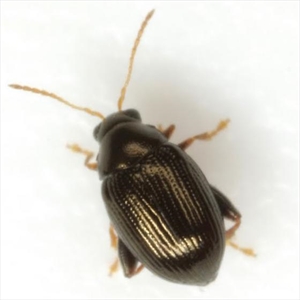Sweetpotato flea beetle
Pacific Pests, Pathogens, Weeds & Pesticides - Online edition
Pacific Pests, Pathogens, Weeds & Pesticides
Sweetpotato flea beetle (096)
Chaetocnema species.The species known as the sweetpotato flea beetle is Chaetocnema confinis, especially in the USA. There may be other species.
Asia, North, South (Brazil) and Central America, Europe (restricted), Oceania. Chaetocnema confinis is reported from French Polynesia, Guam, Marshall Islands, Palau, and Papua New Gunea. Chaetocnema species are present in Fiji, and Solomon Islands.
Sweetpotato, most probably water spinach (kangkong), and wild Ipomoea species in the Convolvulaceae family, of which there are many in the Pacific islands. It is also recorded from bean, cabbage, and cucumber.
The adult beetle does the damage. The beetles (Photo 1&2) are about 1.5 mm long. They feed on the top of the leaves, scraping off the surface and creating light green, pencil thin, irregular feeding marks (Photo 3). Occasionally, when symptoms are sever, rots develop from the feeding marks (Photo 4).
The sweetpotato flea beetle has not been studied in the Pacific islands, so this account is adapted from the life history of other species elsewhere.
The females lay eggs in the soil at the base of sweetpotato or other plants that are hosts. The eggs hatch in 7-14 days, and the larvae, small, white worm-like bodies, feed on the roots. In some species, this causes serious damage, e.g., the larvae of Chaetocnema confinis in the US etch shallow, winding, sunken trails over the storage roots, which enlarge, darken and split. Afterwards, the larvae develop into pupae, and about a week later, into adults.
It is unlikely that the damage caused by the adult beetle affects the yield of sweetpotato storage roots. Sweetpotatoes can lose about one third of their leaves before yields are affected. However, there has been no assessment of the damage done to the feeding roots by the larvae when populations of the beetle are high.
Look for the feeding marks on the top surface of the leaf: they are very distinctive.
CULTURAL CONTROL
- Select vines from plants without the feeding marks, ensuring that the cuttings do not contain adult beetles.
- Do not replant sweetpotatoes in the same plots where beetle damaged occurred in the previous crop; plant them as far away as possible.
RESISTANT VARIETIES
No resistant varieties are known.
CHEMICAL CONTROL
No pesticides are recommended; the damage caused by the beetle is unlikely to affects storage root yields.
AUTHORS Helen Tsatsia & Grahame Jackson
Information from Chris Reid (pers. comm.) Australian Museum, Sydney, Australia; and from CABI (2019) Chaetocnema confinis (flea beetle). Invasive Species Compendium. (https://www.cabi.org/isc/datasheet/12530). Photo 1 Mike Quinn, TexasEnto.net. (http://bugguide.net/node/view/559582). Photos 3&4 Mani Mua, SPC, Sigatoka Research Station, Fiji.
Produced with support from the Australian Centre for International Agricultural Research under project PC/2010/090: Strengthening integrated crop management research in the Pacific Islands in support of sustainable intensification of high-value crop production, implemented by the University of Queensland and the Secretariat of the Pacific Community.







